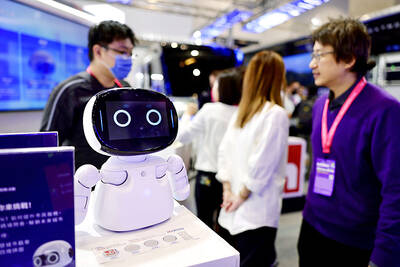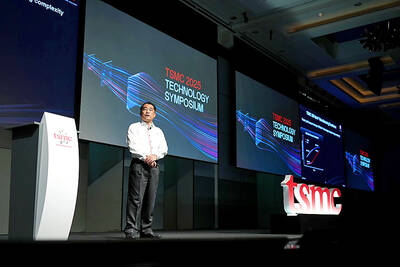Japan’s second-largest steelmaker said yesterday it will shut down one of its blast furnaces from next month as global demand for steel plummets with the economic downturn.
Japan’s JFE Steel Corp said it was cutting production by nearly 26 percent in the second half of this fiscal year.
It decided to close the blast furnace in the western city of Kurashiki in the middle of next month after “comprehensively studying orders, production efficiency and cost,” a company statement said.
JFE Steel plans to cut crude steel output to 11.50 million tonnes in the second half of the year through March, down from 15.49 million tonnes in the first half, a company spokesman said.
The fall is steeper than the production cut of 1.5 million tonnes announced last month.
RENOVATIONS
The blast furnace to be shut down is the company’s oldest and has been in operation for more than 18 years.
“The company will close it for now and put it through renovations, but we have not decided yet when to open the furnace,” the spokesman said.
The World Steel Association said last week that global steel production tumbled 19 percent last month from a year earlier, with North American output dropping steeply.
Steel demand — and prices — had been rising rapidly until the global economic crisis, led by soaring growth in China and other emerging economies.
In related news, China’s leading steel maker Baosteel (寶鋼) will raise prices of major products in February, the first hike since August amid the company’s confidence that demand is growing, state media reported yesterday.
Baosteel will increase the price of cold-rolled steel by 300 yuan (US$44) per tonne, the official China Securities Journal said, citing industry sources.
It did not provide the current price of cold-rolled steel, but data from Lange Steel Consulting firm showed it will mark a rise of 7 percent from next month’s average of 4,271 yuan per tonne for 1mm thick cold-rolled steel.
SUDDEN REVERSAL
Baosteel has cut prices for major steel products four times since August because of weakening demand, the report said.
“The sudden reversal reflects that market confidence has steadily improved and panic selling has gradually disappeared,” Xu Xiangchun, a Beijing-based analyst with Mysteel Research, told the journal.
“In line with Baosteel’s move, other large steel mills like Anshan Steel will also consider raising product prices,” Xu said.
DIFFERING VIEWS
The report added, however, that other analysts argued the price rise did not necessarily signal a general recovery as global demand remained fragile amid spreading economic woes.
China’s steel industry recorded a combined loss in October, the first time in six years it has slipped into the red, earlier media reports said.

DEMOGRAPHICS: Robotics is the most promising answer to looming labor woes, the long-term care system and national contingency response, an official said Taiwan is to launch a five-year plan to boost the robotics industry in a bid to address labor shortages stemming from a declining and aging population, the Executive Yuan said yesterday. The government approved the initiative, dubbed the Smart Robotics Industry Promotion Plan, via executive order, senior officials told a post-Cabinet meeting news conference in Taipei. Taiwan’s population decline would strain the economy and the nation’s ability to care for vulnerable and elderly people, said Peter Hong (洪樂文), who heads the National Science and Technology Council’s (NSTC) Department of Engineering and Technologies. Projections show that the proportion of Taiwanese 65 or older would

Nvidia Corp yesterday unveiled its new high-speed interconnect technology, NVLink Fusion, with Taiwanese application-specific IC (ASIC) designers Alchip Technologies Ltd (世芯) and MediaTek Inc (聯發科) among the first to adopt the technology to help build semi-custom artificial intelligence (AI) infrastructure for hyperscalers. Nvidia has opened its technology to outside users, as hyperscalers and cloud service providers are building their own cost-effective AI chips, or accelerators, used in AI servers by leveraging ASIC firms’ designing capabilities to reduce their dependence on Nvidia. Previously, NVLink technology was only available for Nvidia’s own AI platform. “NVLink Fusion opens Nvidia’s AI platform and rich ecosystem for

Taiwan Semiconductor Manufacturing Co (TSMC, 台積電) yesterday said it is building nine new advanced wafer manufacturing and packaging factories this year, accelerating its expansion amid strong demand for high-performance computing (HPC) and artificial intelligence (AI) applications. The chipmaker built on average five factories per year from 2021 to last year and three from 2017 to 2020, TSMC vice president of advanced technology and mask engineering T.S. Chang (張宗生) said at the company’s annual technology symposium in Hsinchu City. “We are quickening our pace even faster in 2025. We plan to build nine new factories, including eight wafer fabrication plants and one advanced

‘WORLD’S LOSS’: Taiwan’s exclusion robs the world of the benefits it could get from one of the foremost practitioners of disease prevention and public health, Minister Chiu said Taiwan should be allowed to join the World Health Assembly (WHA) as an irreplaceable contributor to global health and disease prevention efforts, Minister of Foreign Affairs Lin Chia-lung (林佳龍) said yesterday. He made the comment at a news conference in Taipei, hours before a Taiwanese delegation was to depart for Geneva, Switzerland, seeking to meet with foreign representatives for a bilateral meeting on the sidelines of the WHA, the WHO’s annual decisionmaking meeting, which would be held from Monday next week to May 27. As of yesterday, Taiwan had yet to receive an invitation. Taiwan has much to offer to the international community’s